




The demand for high-speed internet is growing exponentially, fueled by the rise of 8K streaming, IoT, and cloud applications. Traditional fiber rollouts, while effective, can be costly and time-consuming, especially in suburban and semi-urban areas. Enter MicroPoPs (Micro Point of Presence)—a game-changer for ISPs looking to maximize fiber efficiency while expanding network reach.
What Are MicroPoPs?
MicroPoPs are small-scale, fiber-fed network nodes that act as local distribution points for high-speed broadband services. Unlike conventional fiber-to-the-home (FTTH) deployments that extend fiber all the way to individual residences, MicroPoPs bring fiber close to end-users while leveraging high-capacity wireless or last-mile fiber solutions to complete the connection.
The Role of MicroPoPs in ISP Networks
MicroPoPs are strategically placed within a community to deliver gigabit-capable speeds over a short distance. By deploying MicroPoPs, ISPs can efficiently utilize their fiber backbone while minimizing expensive trenching and infrastructure costs.
Here’s how they fit into modern ISP architectures:
Fiber Backbone Integration – MicroPoPs are connected to an ISP’s core network via regional fiber hubs or aggregation points, ensuring high-speed data transmission.
High-Bandwidth Distribution – From a MicroPoP, ISPs can deploy Fiber-to-the-Curb (FTTC), Fiber-to-the-Building (FTTB), or hybrid fiber-wireless models to serve multiple subscribers.
Reduced Latency & Congestion – By placing data processing closer to users, MicroPoPs improve network efficiency, reducing latency and backhaul congestion.
Key Benefits of MicroPoPs for ISPs
1. Cost-Effective Network Expansion
Deploying FTTH can be prohibitively expensive in low-density regions. MicroPoPs reduce fiber rollout costs while maintaining ultra-fast speeds by serving multiple customers from a single node.
2. Faster Deployment Times
Unlike full-scale fiber deployments, which require extensive civil work, MicroPoPs can be installed quickly using existing infrastructure, significantly reducing time-to-market.
3. Scalability & Future-Proofing
MicroPoPs allow ISPs to scale their networks incrementally. They can start with targeted deployments in high-demand areas and expand based on user adoption.
4. Improved Service Reliability
By decentralizing data distribution, ISPs can enhance redundancy and reliability, ensuring consistent performance during peak usage.
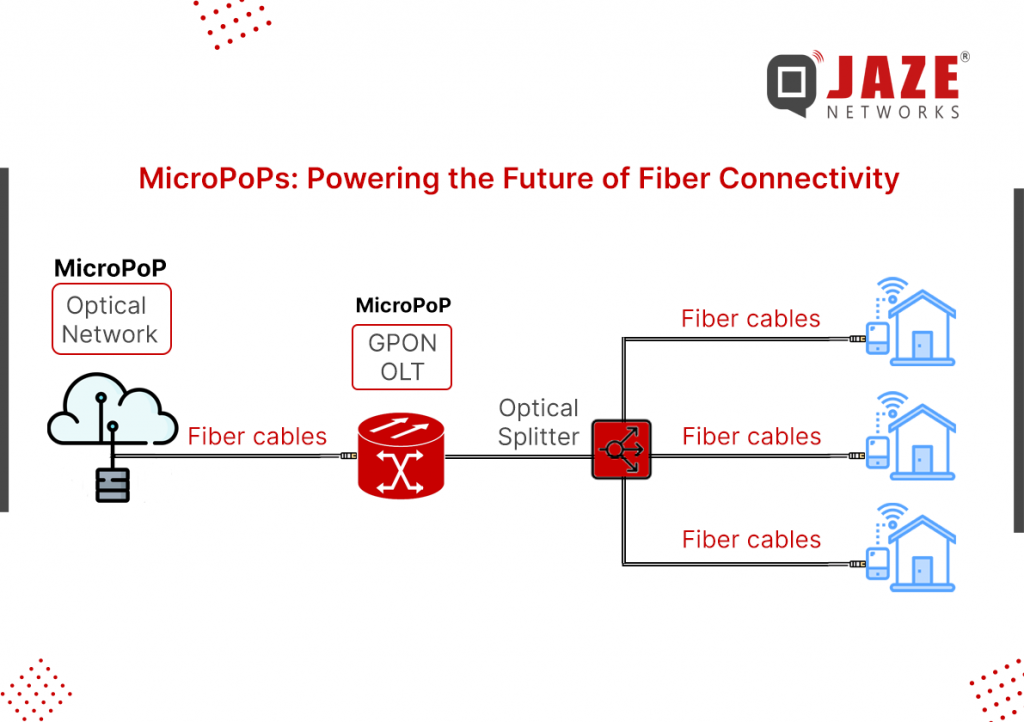
Deployment Considerations for ISPs:
While MicroPoPs offer significant advantages, successful deployment requires careful planning.
Key factors to consider include:
Backhaul Capacity: Ensuring sufficient fiber bandwidth to support high-speed connectivity at each MicroPoP location.
Geographic Placement: Optimal positioning within communities to maximize coverage and minimize last-mile delivery costs.
Regulatory Compliance: Adhering to local infrastructure and right-of-way regulations.
Power & Cooling: Implementing efficient power and cooling solutions for remote MicroPoP units.
The Future of ISP Networks with MicroPoPs
As ISPs strive to deliver multi-gigabit speeds and support the growing number of connected devices, MicroPoPs will play a crucial role in shaping the future of broadband infrastructure. By integrating next-gen technologies like XGS-PON, 5G backhaul, and edge computing, ISPs can create robust, scalable networks that meet the ever-increasing demands of modern consumers.
MicroPoPs represent a strategic approach to fiber network densification, enabling ISPs to offer high-speed internet with cost efficiency and rapid scalability. By leveraging MicroPoPs, service providers can bridge the digital divide, enhance customer experience, and stay ahead in an increasingly competitive market.
Deploying and managing MicroPoPs requires a robust and scalable inventory management solution. Jaze ISP Manager simplifies MicroPoP management by keeping track of inventory at each location.
You can also add additional information to subscribers to track which subscriber is connected to which MircoPoP for easier identification and troubleshooting.
Wi-Fi 7 represents a significant leap forward in wireless networking, offering unparalleled speed, efficiency, and capacity. Its advanced features are set to transform the way we experience connectivity in both home and office environments. Ensuring that networks are equipped to handle the demands of today’s digital world and beyond.
Building upon the foundation of its predecessors, Wi-Fi 7 introduces a suite of enhancements designed to meet the burgeoning needs of modern applications.
Wi-Fi 7, officially known as IEEE 802.11be, is the newest standard in wireless networking. While maintaining backward compatibility with previous Wi-Fi versions, it offers significant improvements in speed, efficiency, and capacity.
While Wi-Fi 7 is backward compatible with earlier Wi-Fi standards, unlocking its full potential requires upgrading to Wi-Fi 7-enabled devices and routers. Early adopters can expect to see routers and access points from major manufacturers becoming available, with devices like smartphones, laptops, and smart TVs following suit. As the technology matures, a broader range of Wi-Fi 7-compatible products will enter the market, making it an opportune time to consider future-proofing your home or office network.
Jaze Access Manager integrates with all leading Wi-Fi 7 vendors to provide managed hotspots and 802.1x authentication with radius based AAA for guest access and campus wireless networks. Click here to know more
In today’s connected world, choosing the right internet service is crucial. With various options available, it can be challenging to determine which one best suits your needs. Two popular choices are fiber and satellite internet. Each has its unique advantages and disadvantages, making them suitable for different situations. Let’s dive into the details to help you make an informed decision.
Fibre internet, powered by fiber-optic cables, is known for its exceptional speed and reliability. Here’s a breakdown of its benefits and challenges:
Satellite internet, as the name suggests, relies on satellites to beam internet signals to users on the ground. While it doesn’t match the speed and reliability of fibre, it has its own advantages, especially in remote or underserved areas.
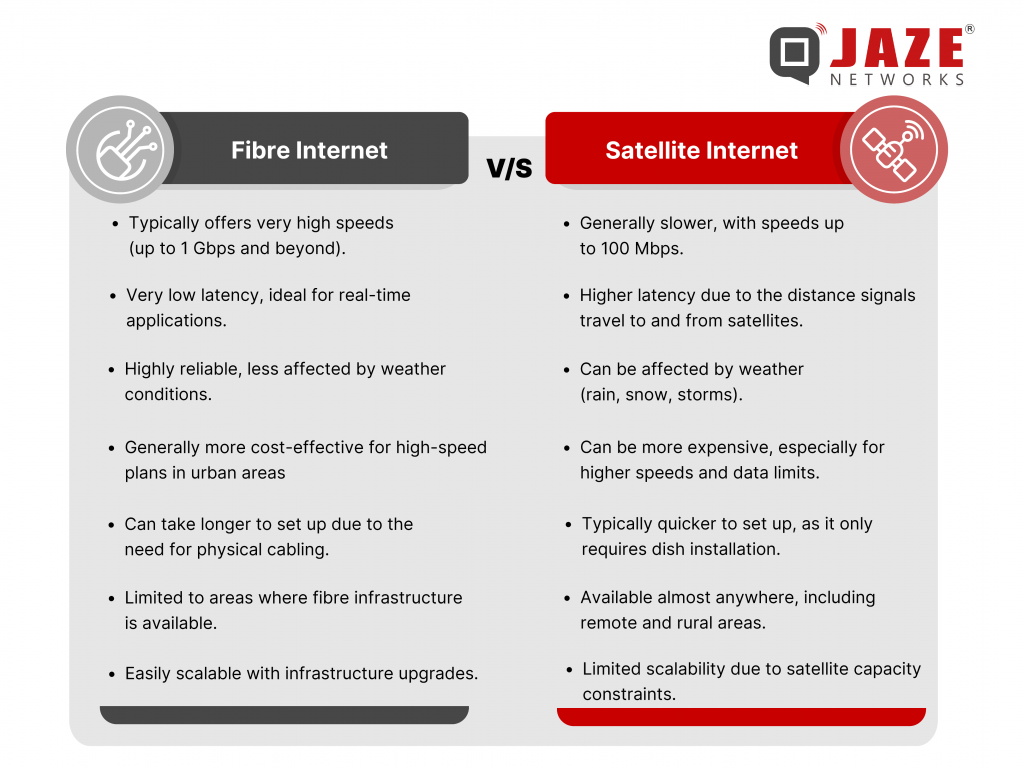
The choice between fibre and satellite internet depends largely on your location, usage needs, and budget.
Despite the growing market of Satellite Internet, fiber based Internet is here to stay. Fiber based ISPs are more reliable with faster speeds and lower latency which provide a better customer experience. ISPs need software to manage their business operations and automate processes.
Jaze ISP Manager integrates with all leading BNG providers to provide scalable and enterprise-grade AAA, BSS and IPDR solutions for ISPs of all sizes. Click here to learn more.
A slow internet connection can be more than just frustrating—it can disrupt work, entertainment, and everyday online activities. Understanding the reasons behind this slowdown and knowing how to fix it can help you get back to enjoying a seamless online experience.
Here are five common reasons why your internet might be slowing down and how you can address them.
Where your router is placed can have a significant impact on the strength and reach of your Wi-Fi signal. If your router is hidden in a closet, placed in a basement, or tucked behind furniture, it’s likely struggling to transmit a strong signal across your home.
Open spaces work best for routers as they minimize obstructions. If your house is large or has multiple floors, consider investing in a mesh Wi-Fi system or a range extender to ensure seamless connectivity in all areas.
The increasing number of connected devices in homes today can overload your network. From smartphones and laptops to smart TVs, gaming consoles, and IoT devices, each connection uses bandwidth. The more devices connected, the slower the speeds for everyone.
Start by identifying devices that don’t need constant internet access and disconnect them. Many modern routers come with Quality of Service (QoS) settings, allowing you to prioritize bandwidth for critical activities such as video calls or gaming. If you frequently face bandwidth issues, consider upgrading to a higher-speed internet plan that can handle multiple devices simultaneously.
Technology evolves quickly, and older routers or devices may not support current Wi-Fi standards. These outdated devices can bottleneck your internet speed, even if your ISP provides high-speed service.
Ensure your router supports modern Wi-Fi standards like Wi-Fi 5 (802.11ac) or Wi-Fi 6 (802.11ax), which offer faster speeds and better handling of multiple devices. Don’t forget to check for firmware updates for your router, as they can improve performance and security.
Wi-Fi signals operate on specific channels, and if your neighbors’ networks use the same channels, interference can slow down your connection. This issue is particularly common in densely populated areas or apartment complexes.
Most modern routers have an option to automatically select the least congested channel. If this feature isn’t available, use tools like a Wi-Fi analyzer app to identify less crowded channels and manually switch your router to one of those. Additionally, placing your router further away from your neighbors’ Wi-Fi sources can reduce interference.
Over time, routers accumulate temporary data that can clog up their system and slow down your connection. A simple reboot can often resolve these minor glitches and restore optimal performance.
Make it a habit to reboot your router at least once a week. Unplug it, wait 30 seconds, and then plug it back in. This clears the router’s memory and refreshes the connection. While rebooting, check for any available firmware updates to ensure your router is running the latest software.
Additional Tips for Improving Internet Speed
Jaze ISP Manager provides built-in integration with broadband routers and CPE devices to monitor Tx/RX levels and Wi-Fi parameters through TR-069 directly from the dashboard. This helps to troubleshoot Wi-Fi signal issues and monitor network performance of end-user devices. Click here to learn more.
Bandwidth is the amount of data transmitted over a network connection in a given time, measured in bits per second (bps) or megabits per second (Mbps). For streaming, it refers to the data sent and received by your device.
Several factors influence the amount of bandwidth needed for streaming:
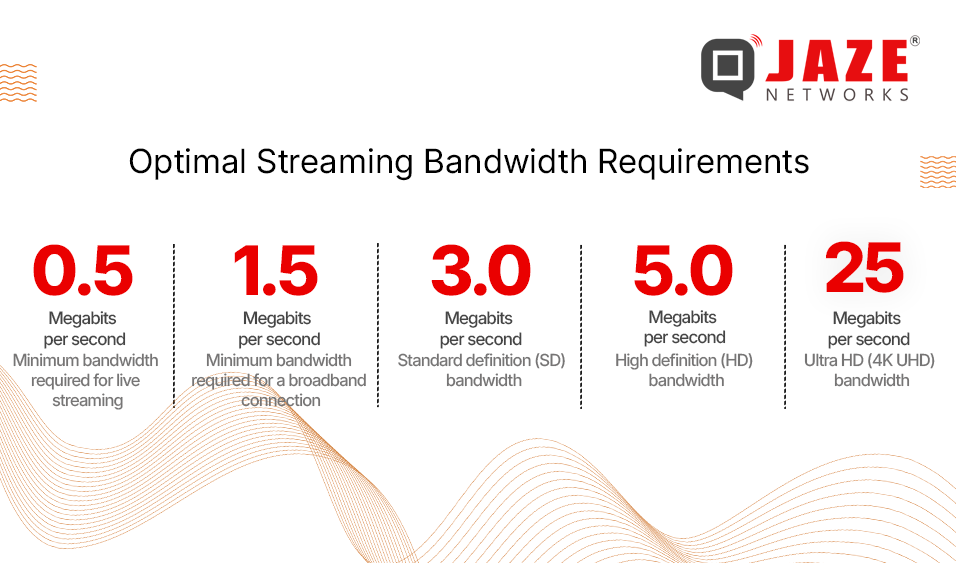
Live streaming requires more bandwidth due to real-time data transmission, while on-demand streaming can buffer content, making it more forgiving on bandwidth. Each streaming platform has its own bandwidth recommendations. For example, YouTube suggests a minimum of 3 Mbps for 720p at 30 fps and 6 Mbps for 1080p at 60 fps. Twitch recommends 3-6 Mbps for most streams.
To calculate your bandwidth needs, use the formula: Bandwidth (Mbps) = Video bitrate (Mbps) + Audio bitrate (Mbps). For instance, 1080p streaming with a 4 Mbps video bitrate and 0.5 Mbps audio bitrate requires 4.5 Mbps total. Add a buffer (25-50%) to account for internet speed fluctuations.
Choosing the Right Codec:
Reducing Video Quality and Frame Rate:
Wired vs. Wireless Connections:
Monitoring and Troubleshooting Bandwidth Issues:
By considering factors like video quality, frame rate, and internet connection, you can estimate your bandwidth needs and make necessary adjustments. Implementing the right strategies will help you enjoy high-quality streams without interruptions.
Jaze ISP Manager provides comprehensive tools for monitoring bandwidth usage, offering real-time insights and detailed usage reports. ISPs can also remotely troubleshoot Wi-Fi issues by gaining insights on connected Wi-Fi devices and signal strength directly from Jaze ISP Manager’s dashboard. Additionally, it allows ISPs to optimize streaming bandwidth by analyzing usage patterns and recommending adjustments to ensure seamless video and audio playback for end-users. Click here for more information.
Launched in 2015, the Digital India Scheme is a transformative initiative by the Indian government aimed at building a digitally empowered society and knowledge economy. The program emphasizes three core areas: delivering robust digital infrastructure, offering government services on-demand, and empowering citizens through digital literacy. With high-speed internet as its backbone, the initiative aspires to bridge the digital divide, stimulate innovation, and foster inclusive growth.
The Digital India Scheme revolves around three key areas:
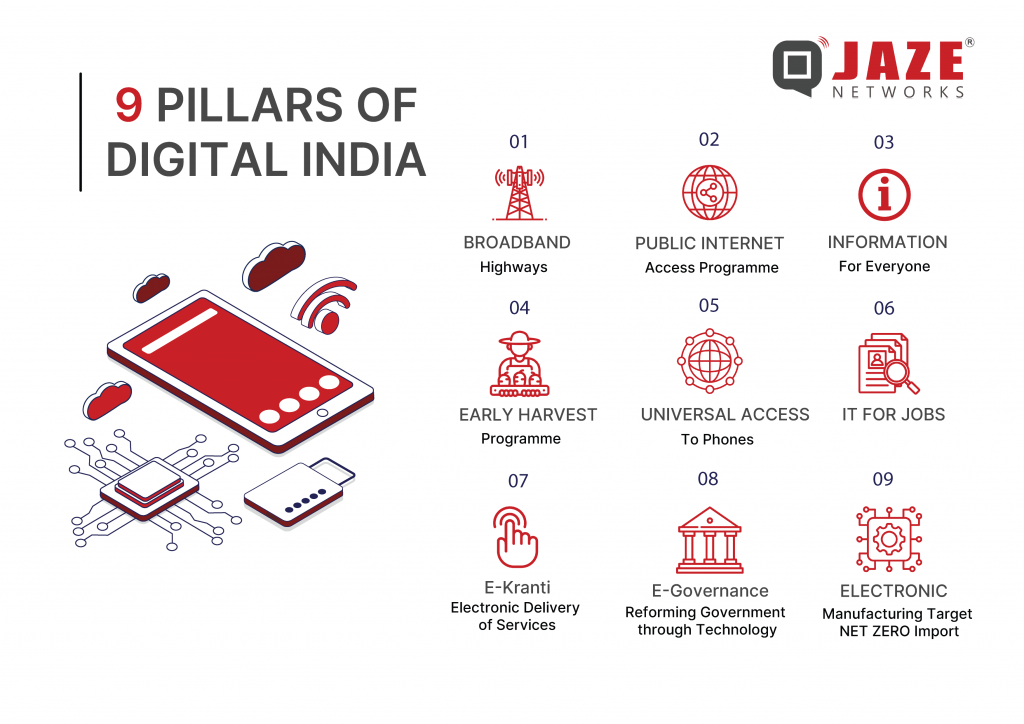
The scheme is built on nine key pillars that drive its mission:
Among these pillars, broadband highways are integral to the program’s success. High-speed internet serves as the backbone for delivering essential services, bridging the urban-rural divide, and fostering economic growth.
The scheme digitizes government services to enhance accessibility. Aadhaar, a unique digital identity, serves as a single authentication point for citizens, streamlining access to various services.
Broadband-enabled CSCs act as hubs for government and private services, including banking, insurance, and digital literacy programs, particularly benefiting rural populations.
With reliable internet connectivity, digital payment systems like Unified Payments Interface (UPI) facilitate secure and efficient transactions, promoting a cashless economy.
Broadband penetration into rural India is one of the most important aspects of the Digital India project which acts as an enabler of other services. The Government of India has deployed a vast network of fiber throughout the country through BHARATNET to connect all Gram Panchayats and villages. Each state has its own special purpose vehicle to make use of the fiber to deliver broadband and other services as part of Digital India.
Broadband delivery requires a complete AAA and BSS solution which integrates with all other components in the network. Jaze ISP Manager delivering an end-to-end solution with comprehensive BSS and AAA solution for broadband delivery across Tamil Nadu through TANFINET. The solution is delivered to be scalable to serve 1 million subscribers delivering high-speed broadband and other services across Tamil Nadu. Click here to learn more.
The modern internet is powered by a vast network of interconnections, enabling seamless data flow between different networks worldwide. One crucial element in this system is Internet Exchange Points (IXPs), which facilitate efficient data exchange between Internet Service Providers (ISPs) and other network operators.
An Internet Exchange Point is a physical location where multiple networks, including ISPs, content delivery networks (CDNs), and other internet-related organizations, connect and exchange traffic. Instead of routing data through third-party transit providers, networks use IXPs to communicate directly. This direct exchange reduces the distance data must travel, improves speed, and minimizes latency.
For example, when two ISPs connect through an IXP, they can transfer data between their networks more quickly and efficiently than if the data traveled through multiple intermediate networks.
At an IXP, networks connect their infrastructure, such as routers and switches, to a shared switching fabric. This setup allows them to exchange routing information and transfer data through direct peering agreements. Typically, networks participating in IXPs use the Border Gateway Protocol (BGP) to manage routing and determine optimal paths for data transfer.
IXPs play a pivotal role in optimizing the global internet infrastructure. By concentrating traffic exchange at specific locations, they reduce the burden on backbone networks and enhance the efficiency of internet traffic delivery.
Additionally, IXPs foster innovation by enabling content providers, ISPs, and enterprises to collaborate. For instance, large-scale streaming services and CDNs rely heavily on IXPs to ensure reliable and high-quality content delivery to users worldwide.
Despite their advantages, IXPs face challenges such as congestion during peak traffic periods and the need for continuous upgrades to handle increasing data volumes. Additionally, establishing an IXP requires cooperation between various stakeholders.
Internet Exchange Points are the backbone of a fast, reliable, and cost-efficient internet. They empower networks to deliver better services while reducing operational costs and fostering global connectivity. As internet usage continues to grow, IXPs will remain essential in ensuring a seamless online experience for users.
IXPs facilitate the interconnection between streaming providers and end-user networks via ISPs, reducing latency and providing a smoother viewing experience. Jaze ISP Manager enables ISPs to set policies that optimize the use of IXPs through supported BNGs, ensuring lower transit costs and an improved Internet experience for end-users. Click here to learn more.
As of 2023, TRAI has highlighted quality of service (QoS) issues as a persistent concern among Indian consumers, with complaints regarding network disruptions, inconsistent speeds, and hidden fees. TRAI receives thousands of complaints monthly, which indicates widespread dissatisfaction with service quality and transparency in ISP billing practices.
A reliable internet connection is as essential as electricity in today’s digital age. Complaints about poor service quality, hidden charges, and inconsistent speeds are widespread. Understanding if you’re getting your money’s worth from your ISP is crucial. Let’s dive into the ways to determine if your ISP is delivering on its promises.
India’s internet landscape shows a stark contrast in accessibility between urban and rural areas. While urban consumers enjoy more ISP options and higher speeds, rural areas still struggle with connectivity. The rural broadband penetration rate is significantly lower than urban, as per TRAI reports, making it challenging for rural consumers to switch to better providers or find competitive prices. This disparity limits consumer choices and leads to dissatisfaction among rural users, who feel locked into subpar services due to a lack of alternatives.
As India’s internet needs grow, consumers deserve ISPs that provide transparent pricing, reliable speeds, and better access across the country.
Jaze ISP Manager helps ISPs streamline operations with feature-rich and configurable modules including lead management, helpdesk, customer portals and mobile applications in order to help serve customers better. These features ensure reliable service delivery and support to provide a great customer experience. Click here to know more.
The world is moving towards an “always connected” reality, with growing numbers of devices demanding ever-increasing bandwidth. This surge in data creates a critical need for robust, secure, and sustainable network solutions. GPON (Gigabit Passive Optical Network) technology stands out as a frontrunner in meeting these demands.
GPON utilizes fiber optic cables to transmit massive amounts of data between a central point and multiple distributed locations, spanning up to 20 kilometers. As the name suggests, it’s a passive network, meaning it doesn’t require any electrical equipment in the signal path, reducing energy consumption.
A GPON network consists of an OLT at the central office. This OLT communicates with ONTs installed at user locations through a fiber optic cable. One OLT port can manage up to 64 ONTs, with passive optical splitters dividing the signal efficiently. Data travels downstream (OLT to ONT) at 2.5 Gigabits per second (Gbps) and upstream (ONT to OLT) at 1.25 Gbps, offering superior broadband capabilities.
GPON transmission relies on a single optical path between the OLT and ONT, using different wavelengths: 1490nm downstream and 1310nm upstream.
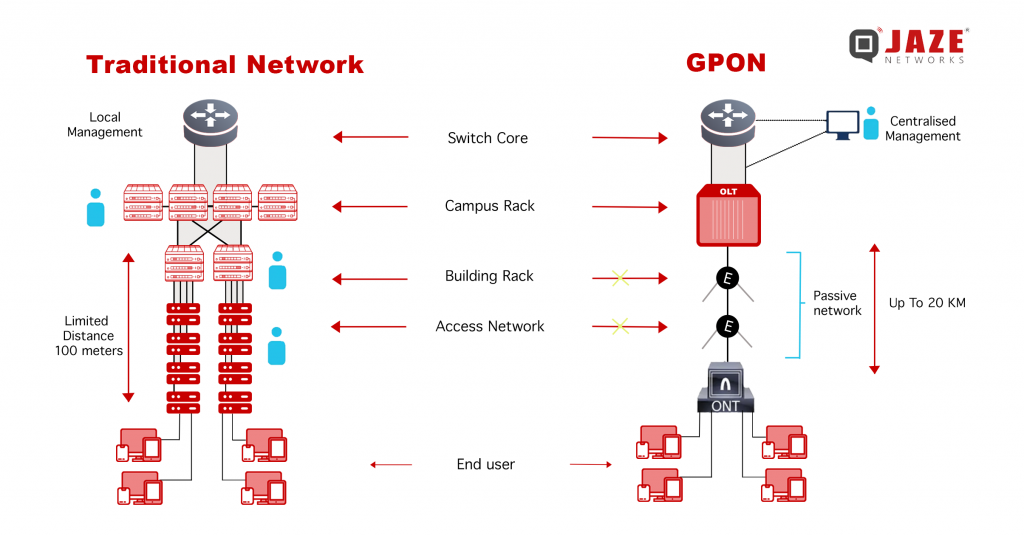
Downstream Transmission: In downstream transmission, data is packaged and addressed at the OLT, distributed in a “broadcast” manner. Each ONT only collects data specifically addressed to it.
Upstream Transmission: In upstream transmission, multiple ONTs send data to the OLT via a single fiber. This is achieved through time slots, where each ONT transmits information in its designated slot.
Technological advancements have led to enhanced GPON protocols like XG-PON, NG-PON2, and XGS-PON, which offer 10 Gbps transmission in both directions.
Superior Bandwidth: GPON offers significantly higher bandwidth compared to traditional copper networks, enabling faster downloads, uploads, and seamless streaming.
Long-Term Scalability: The underlying fiber optic infrastructure in GPON networks boasts a lifespan exceeding 25 years. Upgrading the network to handle future bandwidth demands only requires replacing terminal equipment, not the entire fiber optic cabling.
Sustainability Champion: By reducing reliance on electrical equipment, GPON networks consume considerably less energy, making them a more environmentally friendly solution.
Cost-Effective: Lower equipment requirements and a low-maintenance passive network translate to significant cost savings for both network operators and users.
GPON networks are revolutionizing how we connect, with applications extending beyond traditional internet access:
Remote Work: Reducing the need for commuting, allowing more time for other activities.
Remote Health Services: Minimizing travel and providing faster service.
Online Government Services: Streamlining public services and accelerating processes.
GPON networks are also applicable as local access networks (LANs), potentially replacing existing copper networks in:
ISPs deploying GPON networks need to provision CPE devices and monitor devices for troubleshooting. Jaze ISP Manager provides TR069 based provisioning of credentials, Wi-Fi network provisioning as well as monitoring of critical statistics like fiber power levels and Wi-Fi signal strength.
Jaze ISP Manager also pulls SNMP data to monitor upload and download speeds and device statistics. This information is provided to the administrators along with the other details of the subscriber, thus enabling quick troubleshooting of issues and faster resolution leading to better customer satisfaction.
Also Jaze ISP Manager provides inventory management to manage the device life cycle right from purchase to deployment with end-to-end tracking and accountability helping you get better insights.
Click here to know more on how Jaze ISP Manager can help in managing your GPON deployment efficiently from procurement to provisioning and monitoring.